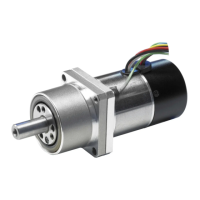2-4 Duty Cycles
2-8
Selection of the RSF supermini Series
Examining effective torque and average rotational speed
Addionally to the former studies, the effective torque and the average speed should be studied.
(1) The effective torque should be less than allowable continuous torque specified by the driver.
(2) The average speed should be less than allowable continuous speed of the actuator.
Calculate the effective torque (Tm) and the average speed of an operating cycle (Nav) as shown in
[Calculating equivalent duty] (P2-4).
If the calculation results for the effective torque and average rotation speed are not within the range of
continuous usage in the graph shown in [1-15 Operable range] (P1-15) take measures to reduce the
duty.
Example 3: getting effective torque and average speed
Effective torque and average speed are studied by using the operation conditions of Example 1 and 2.
1) Effective torque
From the parameters of T
a = 8.3 N・m, Tr = 0 N・m, ta = 0.113 s, tr = td = 0.03 s, t=0.4 s,
( )
mN349.0
4.0
03.003.09.0
T
2
m ⋅=
+×
=
The value exceeds the allowable continuous torque (0.29 N・m) of RSF-5B-50 temporarily selected in
Example 1, so continuous operation cannot be done using the cycle set in Example 2. The following
formula is the formula for effective torque solved for t. By substituting the value of allowable
continuous torque in T
m
of this formula, the allowable value for one cycle time can be obtained.
Substituting 0.9 N・m for T
a, 0 N・m for Tr , 0.349 N・m for T
m
, 0.03 s for ta , 0.113 s for tr, and 0.03 s for
t
d :
( )
]s[578.0
0.29
0.030.030.9
t
2
2
=
+×
=
Namely, when the time for one duty cycle is set more than 0.578 s, the effective torque [T
m] becomes
less than 0.29 N・m, and the actuator can drive the load with lower torque than the continuous torque
continuously.
・
・
・
running time at
constant speed

